Abstract
Recently, with the development of automobile technologies such as advanced driver assistance systems (ADASs), the performance and number of cameras and displays required for a vehicle have significantly increased. Therefore, the need for in-vehicle high-speed data transmission has increased, but there is difficulty in handling the required high-speed data transmission in existing in-vehicle networks. The MIPI A-PHY interface for automobiles has been proposed as a new standard to solve this issue. To ensure data transmission in noisy automotive environments, the A-PHY interface contains an added retransmission (RTS) layer within the new physical layer. In this paper, we propose and design in detail the structure of an RTS layer presented in the standard A-PHY interface. The proposed RTS layer was designed to satisfy the RTS specification of the MIPI A-PHY standard and was verified through simulations. Moreover, the A-PHY SerDes environment was configured in an FPGA using a Xilinx KC705 FPGA development board and an FPGA Mezzanine Card (FMC) loopback module, and RTS layer operation was verified through the process of transmitting video data to the A-Packet. The A-PHY interface with the RTS layer designed on the FPGA uses 3924 LUTs, 2019 registers, and 132 block memories and operates at a maximum speed of 200 MHz. In addition, as a result of designing the A-PHY interface as an ASIC implementation using the Synopsys SAED 28 nm process, the number of logic gates is 25 K, the chip area is 0.40 mm, and the maximum operating speed is 200 MHz.
1. Introduction
With the development of automobile technology, many electronic control units (ECUs) are being connected to vehicles. In particular, automated driving systems (ADSs) and advanced driver assistance systems (ADASs) have significantly increased the number and performance of cameras and displays in vehicles [1,2]. Accordingly, a high transmission rate of 1 to 16 Gbps is currently required, and it is expected that the data transmission rate will be increased to 100 Gbps in 2025 [3,4]. However, existing in-vehicle networks such as controller area networks (CANs), local interconnected networks (LINs), and flexray and media-oriented system transport (MOST) have the problem of the transmission rate being limited to 1∼150 Mbps [5].
Automotive Ethernet and Serializer/Deserializer (SerDes) physical (PHY) layers have been widely studied as new PHY layers for in-vehicle networks. Besten et al. [6] emphasized that new PHY technology is needed as a data streaming solution for high-resolution sensors rather than the Ethernet. Ahmadi et al. [7] gave an example of the data transmission speed required for automobiles and talked about the need for SerDes transmission for asymmetric data transmission, such as cameras and displays. Kraemer [8] introduced conferences held for Automotive Ethernet and the development of standards, including 802.3 (Ethernet) and 802.1 (Mac bridge). Hank et al. [9] explained the importance of Ethernet and PHY interfaces that provide scalability and flexibility for next-generation in-vehicle networking. Ashjaei et al. [10] introduced the Ethernet as a high-bandwidth, low-latency data transmission technology for future autonomous vehicles. Law [11] introduced a proposed standard with multi-gigabit optical Ethernet for automobiles. The automotive Ethernet is a full-duplex method, which is helpful in the backbone network configuration but has low efficiency in asymmetric connections such as cameras and displays [12,13,14]. Therefore, the need for automotive SerDes PHY, which is a high-speed asymmetric solution, has increased. Gigabit multimedia serial links (GMSLs) [15], flat panel display links (FPD-Links) [16] and automotive pixel links (APIXs) [17] are currently used automotive SerDes, but they have a transmission rate of 4∼6 Gbps and are proprietary technologies.
The automotive SerDes Alliance (ASA) and A-PHY interfaces were proposed as new open standards to meet the demand for higher transmission speeds [18,19]. ASA and A-PHY interfaces are similar automotive SerDes standards that support transmission rates of 2∼16 Gbps. However, the difference is that the ASA interface uses forward error correction, and the A-PHY interface uses retransmission-based error correction. Among them, A-PHY has already been adopted as an IEEE standard [19], and development of the next version supporting a transmission rate of 32 Gbps is being prepared [20].
The A-PHY interface is a standard created by Mobile Industry Processor Interface (MIPI), which has created a physical level retransmission (RTS) scheme to obtain noise immunity in noisy automotive environments [19]. RTS is performed in the RTS layer, which is a new physical layer of A-PHY, and the A-PHY interface offers a low packet error rate of 10 using RTS [21,22].
In this paper, we propose designing and implementing a detailed architecture for the RTS layer presented in the standard A-PHY interface in an FPGA and an ASIC. The contributions of this paper are as follows:
- Based on the RTS specification of the A-PHY interface standard, the detailed structure of the RTS layer, including the transmitter and receiver, was proposed and verified. More specifically, we presented the hardware architecture of the MC (message counter) handler, scheduler, delay, and CRC updater specified in the RTS layer of the A-PHY interface.
- The A-PHY interface, including the RTS layer, was implemented and verified on FPGA. As a result of implementation on the Xilinx KC705 board, 3924 LUTs, 2019 registers, and 132 block memories were used, and the maximum operating speed was confirmed to be 200 MHz.
- The RTS layer of the A-PHY interface was implemented as an ASIC using the Synopsys SAED 28 nm process. As a result of the implementation, it was confirmed that the number of logic gates used was 25 K, the chip area was 0.40 mm, and the maximum operating speed was 200 MHz.
The rest of this paper is organized as follows. In Section 2, the A-PHY interface standard is described. Section 3 presents the structure of the proposed RTS layer. Section 4 introduces the verification environment of the A-PHY interface. Furthermore, the proposed RTS hardware architecture of the A-PHY interface is validated via register transfer level (RTL) simulations, accompanied by the outcomes of field programmable gate array (FPGA) verification and application-specific integrated circuit (ASIC) implementation. Finally, we conclude this work, and future research is discussed in Section 5.
2. Related Works
This section introduces the architecture of the A-PHY interface and explains the structure of the A-Packet format, physical coding sublayer (PCS) architecture, and retransmission (RTS) layer structure specified in the A-PHY interface standard.
2.1. A-PHY Architecture
In the A-PHY configuration, a source exists, exemplified by devices like cameras, which is responsible for data transmission, and a sink also exists, analogous to an ECU, designated for data reception. This source and sink are connected by a downlink through which data are transmitted and an uplink through which control signals are transmitted, and are composed of a link layer, an RTS layer, a physical coding sublayer (PCS), and a physical medium dependent (PMD), as shown in Figure 1. The link layer converts the data format into A-Packet, which is the data format of the A-PHY interface, and connects the upper protocol such as a camera serial interface (CSI) or a display serial interface (DSI) [23,24] with the A-PHY interface. The RTS layer modifies the PHY field of A-Packet and performs RTS. The PCS performs A-PHY start-up and converts the A-Packet into a physical layer symbol. The PMD defines electrical specifications and physical media.
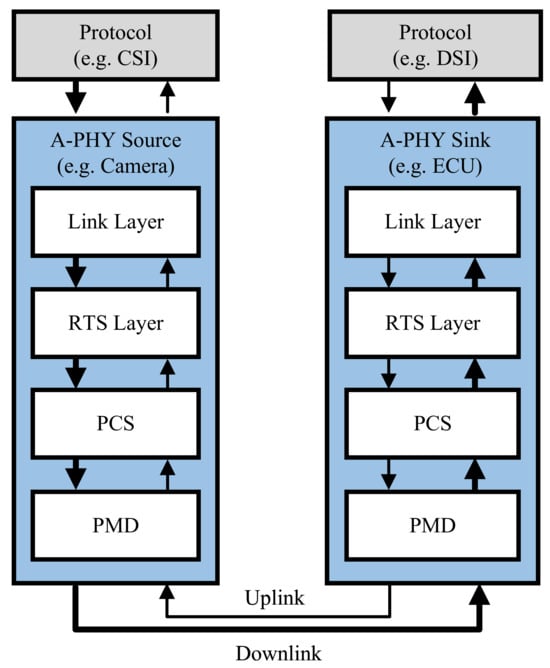
Figure 1.
A-PHY architecture.
2.2. A-Packet, A-PHY Data Transmission Format
An A-Packet, the data format used in the A-PHY interface, comprises a header, payload, and tail, as shown in Figure 2. The header consists of 8 bytes and includes the type of upper protocol, transmission priority, and PHY field. The PHY field of the header consists of three types of data. There is an 8-bit message counter (MC) to detect A-Packet loss and a cyclic redundancy check (CRC) to detect errors and delays. The delay field is the sum of the transmission delay in the link and the delay by RTS and prevents a significant delay of the PHY level compared to the max RTS time of the standard. The payload consists of data to be transmitted and has a maximum length of 380 bytes in the downlink and 32 Bytes in the uplink. The CRC32 value is inserted in the tail field to check the error of the entire A-Packet.

Figure 2.
A-Packet format.
2.3. Physical Coding Sublayer (PCS)
The mission of the physical coding sublayer (PCS) of the A-PHY interface is to transmit data from source to sink or from sink to source. The entire block diagram of the PCS layer can be seen in Figure 3. Within the PCS layer, a byte stream controller distinguishes transmission data such as A-Packets and retransmission requests. The byte stream controller is also used to initialize and synchronize the modules. Furthermore, within the PCS layer, a scrambler/descrambler and an 8B10B encoder/decoder are used for symbol conversion, DC balancing, and clock recovery.
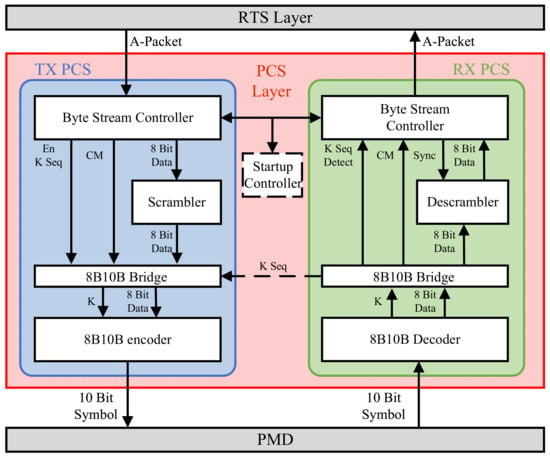
Figure 3.
A block diagram of physical coding sublayer (PCS).
In the byte stream controller, the distinction between transmission data and startup sequence is made by transmitting a control mark (CM) and two 4-bit control nibbles (CNs). The CNs distinguish between the startup sequence and the normal state. In addition, the CN used in the startup sequence is shown in Table 1, and the startup sequence is performed step-by-step by transmitting the startup control sequence. Figure 4a shows the control sequence for entering the idle phase from the startup sequence to the idle state, and Figure 4b shows the control sequence for entering the normal state from the idle phase. The CN used in the normal sequence is shown in Table 2. With this control signal, it is possible to distinguish between the start and end of the A-Packet, retransmission request, and acknowledgment transmission data. Figure 5 shows an example of A-Packet transmission in the normal state. The ‘*’ in the CN indicates that a different CN can be used depending on the front and back status.

Table 1.
The control nibbles (CNs) of the startup sequence.
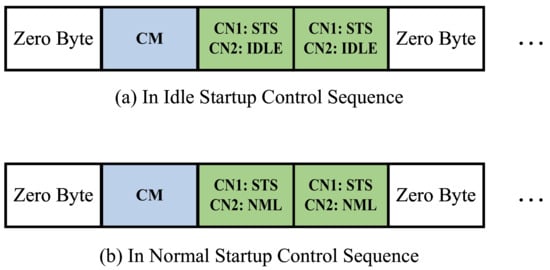
Figure 4.
A-PHY startup control sequence.

Table 2.
The control nibbles (CNs) of the normal sequence.
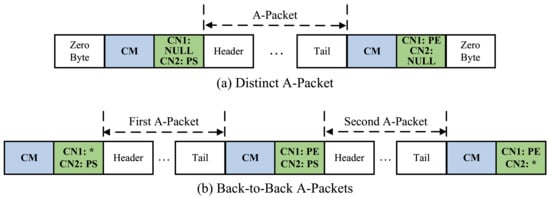
Figure 5.
A-Packet transmission example in the normal sequence.
The scrambler randomizes the data pattern, prevents the transmission of continuous bit strings of ‘1’ or ‘0’, and helps equalize the receiving side by maintaining an appropriate number of data transitions. The scrambler and descrambler used in the PCS layer of the A-PHY interface use a 58-bit linear feedback shift register (LFSR). The LFSR used in the downlink must satisfy the polynomial in Equation (1), and in the uplink, it must satisfy the polynomial in Equation (2).
Data scrambling performs exclusive OR of 8 bits of data and the lower 8 bits of the scrambler. Currently, the LFSR used in the scrambler and descrambler is initialized and synchronized to a non-zero value in the A-PHY startup sequence. Moreover, the PCS of the A-PHY interface uses an 8B10B encoder and decoder to adjust DC balancing and recover the clock. The 8B/10B uses an algorithm that divides 8-bit data into 3-bit and 5-bit data and then converts it to 4-bit and 6-bit data [25,26]. The converted 4- and 6-bit data are combined to create a 10-bit symbol. Additionally, there is a 1-bit control signal separate from the data, and when the control signal is used, a control symbol rather than a data symbol is generated and transmitted.
2.4. Retransmission (RTS) Layer
The retransmission (RTS) specification of the A-PHY interface corrects the error packet through the cyclic redundancy code (CRC), message counter (MC), and delay fields of the A-Packet. Error correction is performed by sending the RTS request from the sink to the source through the uplink. If the sink finds a damaged A-Packet through the CRC, it should send a single RTS request, including the message counter (MC) of the damaged A-Packet. Similarly, if an A-Packet loss is discovered through the MC, a gap RTS request should be sent with the MC, indicating the loss range. Figure 6a illustrates a singular retransmission request, while Figure 6b depicts a request for range retransmission.
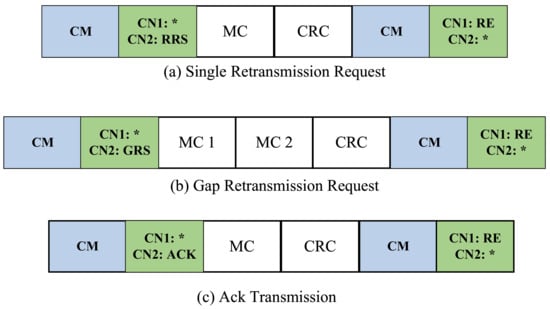
Figure 6.
A-PHY retransmission request and ACK transmission format.
Conversely, if the total transmission delay at the sink is more significant than the max RTS delay time of the standard, the RTS request must not be sent to prevent a considerable delay caused by using repeated RTSs. At this time, the total transmission delay is calculated by the delay field of the A-Packet, and the max RTS delay time is 6∼12 us depending on the transmission speed. If the error is not continuously corrected, the A-PHY interface performs the start-up sequence again. Additionally, the A-Packet is stored in the buffer for RTS, and an acknowledge (ACK) signal can be selectively sent to prevent the buffer from being complete. Figure 6 shows the control signal of the ACK transmission signal. Detailed descriptions of TX and RX RTS architectures are provided in the following sections.
3. Proposed RTS Layer
The proposed RTS layer of the A-PHY interface consists of TX RTS, RX RTS, and a request generator, as shown in Figure 7. TX RTS is configured to store the A-Packet to be transmitted for RTS and insert the CRC, message counter (MC), and delay time in PHY fields into the A-Packet. Conversely, the architecture of RX RTS is designed to evaluate the CRC, MC, and delay fields, subsequently issuing RTS requests in the event of discrepancies. In conclusion, A-PHY, characterized as an asymmetric transmission architecture, exhibits disparate transmission rates between TX RTS and RX RTS. As a result, the Request Manager module facilitates clock domain crossing of the retransmission (RTS) request signal utilizing FIFO mechanisms. In the subsequent subsections, the methodologies for implementing TX RTS and RX RTS, as proposed in this study, are presented comprehensively.
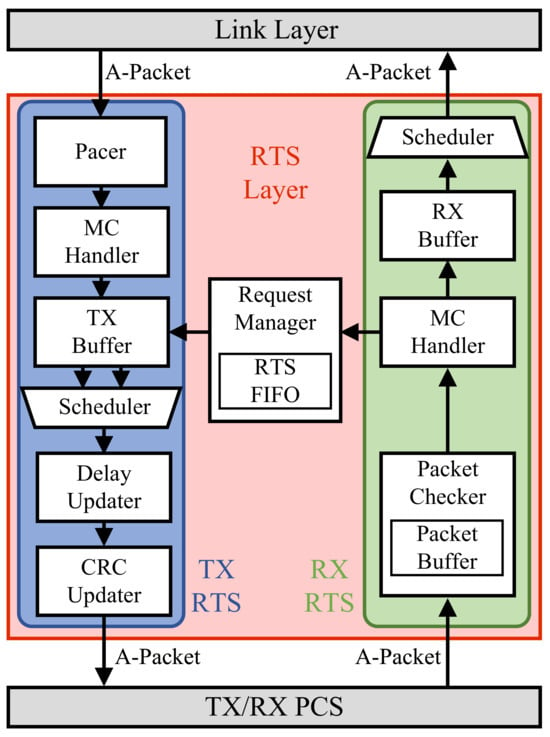
Figure 7.
A block diagram of A-PHY RTS layers of the source and sink.
3.1. TX RTS Architecture
As shown in Figure 7, the structure of TX RTS is composed of several modules: a Pacer, a TX MC handler, a TX buffer, a TX scheduler, a delay, and a CRC updater. The Pacer module governs the transmission of A-Packets from the data link layer to the physical layer, accommodating the overhead and retransmission introduced based on the control signal and the 8B10B encoding inherent in the A-PHY interface. The overhead for a single transmission encompasses an 8-byte header, a 4-byte tail, an additional 2 bytes for control in the PCS, and finally, the 8B10B encoding applied to every byte. Given that each byte is transformed into a 10-bit symbol due to the 8B10B encoding, the transmission duration for each byte equates to 10/GearBW (bps). Consequently, the actual transmission time for an A-Packet can be deduced using Equation (3).
In the given scenario, a minimum of 2.5% of the physical transmission rate is mandated for retransmission, which implies that a maximum of 97.5% of the rate is available for the original A-Packet transmission. Consequently, the Pacer module modulates the A-Packet transmission from the data link layer, ascertaining the compensatory time such that the actual A-Packet transmission time remains confined to 97.5% of the physical transmission capacity, as depicted in Figure 8.

Figure 8.
Fully paced A-Packet transfer.
The computation of the compensatory time by the Pacer module leverages the fact that the proportion of the original A-Packet within 97.5% of the physical transmission volume is represented as a 39/40 ratio. During the transmission of the original A-Packet, a value of 40 is appended to each byte, and 39 is deducted from all bytes, resulting in a negative sum. This process ensures a minimum compensation time of 2.5%, preparing for the subsequent A-Packet transmission. Therefore, the Pacer module’s architecture is formulated to produce a compensation time that spans between a minimum of 2.79% and a maximum of 6.25% of the physical transmission volume, contingent upon the payload’s length.
The TX message counter (MC) handler module assigns sequential 8-bit values to the MC, which is the PHY field of the A-Packet header. Currently, the MC is a standard for each A-Packet in each A-PHY interface and is used to detect omissions between transmitted A-Packets or in retransmission. Figure 9a shows the block diagram of the proposed TX MC handler. MC values are managed through the MC window. When a new A-Packet is transmitted, the maximum value of the MC window increases, and the maximum value of the MC window is given to the A-Packet. Conversely, when the A-Packet is stored for a long time when an acknowledge (ACK) signal is received or recorded through a time checker, the minimum value of the MC window increases. The MC window is designed to control the TX buffer so that it does not become full, and if the buffer is full, it sends a signal to the Pacer so that it does not receive a new A-Packet. At this time, the maximum size of the MC window in the downlink is 128, and in the uplink, it is designed to have a maximum size of 16.
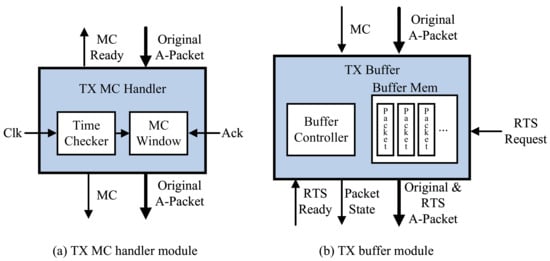
Figure 9.
A block diagram of proposed TX MC handler and TX buffer.
The TX buffer stores the A-Packet being transmitted for retransmission. Figure 9b shows a block diagram of the proposed TX buffer consisting of a controller and memory. The controller stores and reads the A-Packet’s MC as the address. The memory size is determined according to the maximum size of the MC window. The TX scheduler determines the transmission priority between the original A-Packet and the retransmitted A-Packet. Generally, the priority of a retransmitted A-Packet is higher than that of the original A-Packet, but if there has already been a delay in the transmission of the original A-Packet due to retransmission, the transmission of the original A-Packet is given priority. Therefore, the TX scheduler receives the status of the A-Packet from the TX buffer and transmits the retransmitted A-Packet when there is no problem.
The delay updater module inserts the transmission delay time in the RTS layer, including retransmission, into the Delay field of the PHY field of the A-Packet header. The transmission delay time is calculated using the time difference between the transmission time in the delay updater based on the storage time for each A-Packet recorded in the MC handler. As shown in Equation (4), the transmission delay time is divided into units to be inserted into the header and converted into a 7-bit normalized RTS layer delay time. The delay time is inserted into the 8-bit header, and the remaining 1-bit indicates the original A-Packet.
The cyclic redundancy check (CRC) updater is a module that generates a CRC to detect errors and inserts it into the PHY field of the A-Packet header and tail. The CRC is created and transmitted based on the transmitted data, and the receiving side generates a CRC again based on the transmitted data and compares it with the transmitted CRC to detect errors. Currently, the header’s CRC is an 8-bit CRC-8, which detects only header errors, and the tail’s CRC is a 32-bit CRC, which detects payload errors. Figure 10a is the linear feedback shift register (LFSR) for the CRC used to generate CRC-8, and the polynomial used in the CRC is Equation (5). Similarly, the CRC LFSR and polynomial used to generate CRC-32 are shown in Figure 10b and Equation (6). The LFSR shown in Figure 10a,b has a structure in which only one bit moves for each clock. In this paper, since 8 bits are processed every clock, we designed a parallel LFSR in which 8 bits are moved every clock while satisfying Equations (5) and (6).
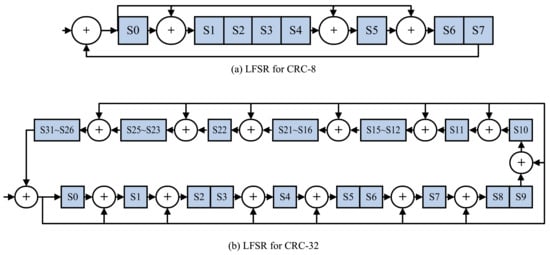
Figure 10.
A block diagram of LFSR for CRC-8 and CRC-32.
3.2. RX RTS Architecture
As shown in Figure 7, the structure of the RX RTS is composed of several modules: a Packet checker, an RX MC handler, an RX buffer, an RX scheduler, and an RTS request manager. The packet checker module is a module that checks the PHY field of the received A-Packet. The module extracts MC and Delay from the A-Packet header, transmits them, and checks whether CRC-8 and CRC-32 errors occur. At this time, the A-Packet is stored in the buffer to check the CRC-32 in the tail of the A-Packet. Figure 11a shows the block diagram of the proposed packet inspector module. The RX MC handler module manages the received A-Packet with an MC window, similar to the TX MC handler. The RX MC handler decides whether to store, discard, or retransmit the A-Packet based on the status of the packet received from the packet checker. Figure 11b shows the block diagram of the proposed RX MC handler.

Figure 11.
A block diagram of proposed RX packet checker, RX MC handler, and RTS request manager modules.
When an A-Packet is received, first, CRC-8 errors are checked for. The received A-Packet is discarded if a header error is detected through CRC-8. Afterwards, the MC is used to check whether the A-Packet is missing. In addition, the CRC-32 value included in the A-Packet is compared with the CRC-32 value calculated by internal logic to check whether an error has occurred in the payload and then decide which retransmission request to perform. Finally, the transmission delay time of the A-PHY interface calculated through the Delay field is compared with the maximum retransmission delay time to determine whether to request retransmission. At this time, the maximum delay time that can occur due to one retransmission occurs when transmitting an A-Packet with the maximum length payload at the lowest standard PHY transmission rate, which is approximately 4 s.
Figure 12 shows the operation sequence according to packet status when receiving an A-Packet. A retransmission request is made by sending a retransmission request signal to the retransmission request manager along with A-Packet’s message counter (MC). Apart from the retransmission request, if there are no errors in the currently and previously received A-Packets, an acknowledgment signal is transmitted through the retransmission request manager.
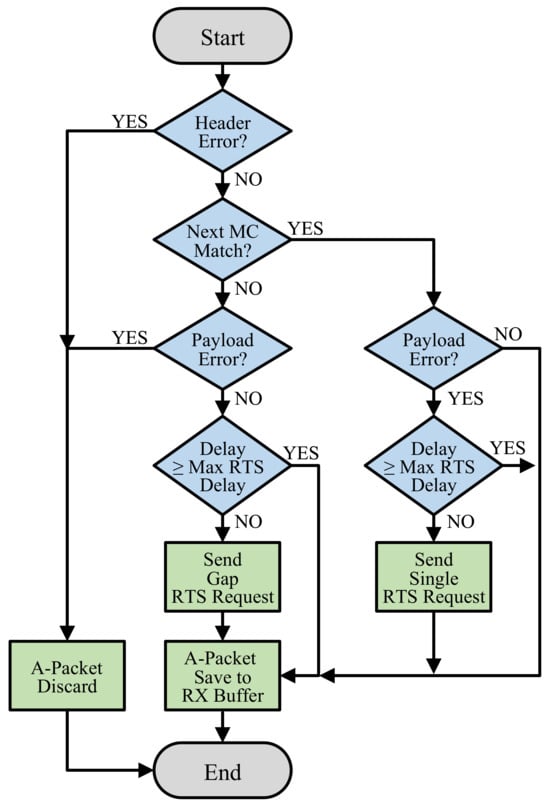
Figure 12.
Flow chart of RTS in RX RTS.
The RX buffer in the RX RTS stores the received A-Packet and waits for the A-Packet request to be retransmitted. Like the TX buffer in the TX RTS, it consists of a controller and memory and stores and reads the A-Packet’s MC as the address. The memory size is also determined by the maximum size of the MC window, like the TX buffer. The RX scheduler transmits the A-Packet stored in the RX buffer to the data link layer according to the transmission order based on the MC. If a damaged A-Packet is stored in the RX buffer, the RX scheduler stops transmission and waits for the error to be restored through retransmission. If the error is not restored by the maximum retransmission delay time allowed in the A-PHY interface, the RX scheduler passes the damaged A-Packet as it is to the data link layer.
The retransmission request manager is a module that transmits the generated retransmission request and acknowledgment signal to the other side through downlink and uplink with different speeds. The retransmission request manager receives values from RX RTS and the PCS and transmits the retransmission request from RX RTS to the other side through the PCS. Therefore, the input from the PCS is the retransmission signal requested from the other side and delivered to TX RTS. At this time, because the operation speeds of the downlink and uplink are different, the retransmission request is transmitted using the FIFO module. Figure 11c shows the block diagram of the proposed retransmission request manager.
4. Experimental Results
This section presents the verification environment of the A-PHY interface, including the proposed RTS layer. Moreover, the operation of the proposed RTS layer was verified in an FPGA, and the results of the ASIC design are shown.
A block diagram for A-PHY verification, including the RTS layer, is shown in Figure 13. It is composed of the A-PHY source, sink, and module for verification. The source and sink of the A-PHY interface consist of the RTS layer and an 8B10B PCS. The link layer of the A-PHY interface and higher protocol is implemented by replacing the video data generator that generates VGA (640 × 480)@60 fps videos, the HDMI interface that outputs video, and the converter module that converts data format. The transmission result of the A-PHY interface, including the RTS layer, is checked through the monitor connected via HDMI. The PMD that transmits actual data is implemented using a high-speed serial [27] module of the FPGA, and the uplink and downlink are configured by connecting the FPGA mezzanine card loopback module. The downlink and uplink transmission rates are 2 Gbps and 100 Mbps. An UART to the AHB bridge module connects the A-PHY start-up control module and the host computer to control PCS start-up through the UART terminal. The error generator module was also inserted in front of the A-PHY sink to check the RTS specification.
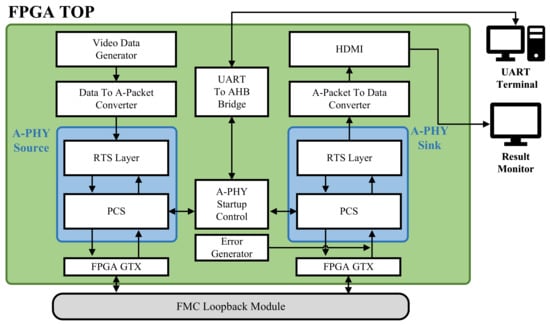
Figure 13.
A verification block diagram for A-PHY RTS layer in an FPGA.
For FPGA validation, we used a Xilinx KC705 development board [28] and included the source and sink of the A-PHY interface and verification modules in one FPGA. The A-PHY environment, including serializer and deserializer (SerDes), was configured as shown in Figure 14 using the FPGA GTX transceiver [29], which is a high-speed serial interface for the KC705 board. In addition, an FPGA mezzanine card (FMC) loopback module [30] from the company IAM was used. As shown in Figure 14, the FMC loopback module reproduced the channel when transmitting and receiving data between the source and sink. The FMC loopback module allows easy prototyping, analysis, and testing of high-speed data links using the GTX transceiver provided by the FPGA board. At this time, the error generator module and RTS operation are controlled by a switch.
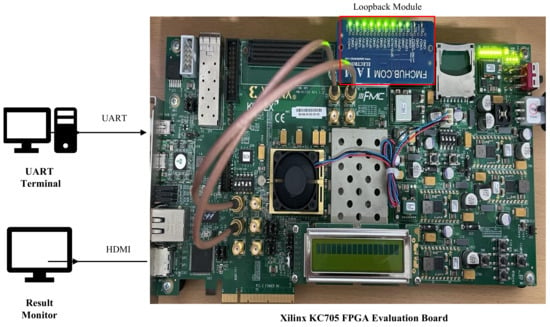
Figure 14.
FPGA verification environment for the proposed A-PHY RTS architecture.
Figure 15 shows a waveform of the single and gap RTS requests. Figure 15a is a simulation of a CRC32 error occurring in the received A-Packet where the error is corrected with a single RTS request. The RX RTS recognizes a problem in the payload of the A-Packet with an MC of 52 through the CRC32 error and transmits the single RTS request through the uplink. This single RTS request consists of the MC 52 of the A-Packet where the error occurred and the control data in the front and back. After that, it can be confirmed that the A-Packet in which the error occurred is retransmitted and received through the downlink. Figure 15b is a simulation of error correction with gap RTS requests due to loss in the A-Packet. The A-Packet with MC 33 was discarded because a CRC8 error was detected in the header of the A-Packet. After that, the RX RTS receives the A-Packet of the MC 34, detects a loss, and sends the gap RTS request through the uplink. These gap RTS requests are similar to a single RTS request but transmit two message counters, 32 and 34, to indicate the range of loss. After that, it can be confirmed that the missed A-Packet is retransmitted and received through the downlink.
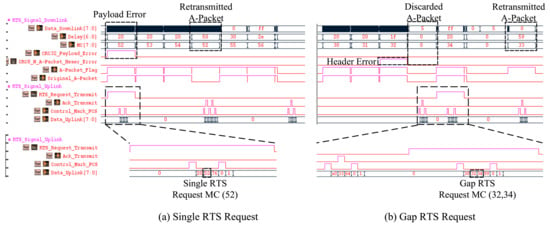
Figure 15.
A waveform of single and gap RTS requests.
Figure 16 shows the video data transmitted through A-PHY being output through the monitor. Figure 16a shows that the video created by the video data generator module is output to the monitor without the error insertion and RTS functions. Figure 16b shows noise in the output video due to an error inserted with the error generation module in operation. Finally, when the RTS function is in operation, the error is corrected and a noise-free image is output, as shown in Figure 16c. Table 3 shows the FPGA synthesis results of the A-PHY source and sink, including the RTS layer. As a result of FPGA synthesis, 3924 LUTs and 2019 registers use less than 1% of resources and 132 block memories use approximately 30% of resources to store A-Packets in RTS operations. We confirmed that the proposed RTS hardware of the A-PHY interface does not use DSP. Moreover, the proposed system operates at up to 200 MHz on the KC705 FPGA board.
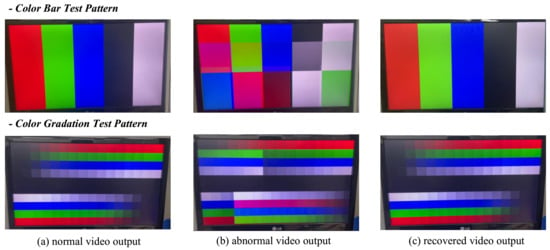
Figure 16.
An FPGA demonstration of the proposed A-PHY RTS hardware. (a) Normal video output: error insertion ✗. (b) Abnormal video output: error insertion ✓ and RTS function ✗. (c) Recovered video output: error insertion ✓ and RTS function ✓.

Table 3.
A summary of FPGA implementation results of the A-PHY source/sink.
An ASIC was implemented in the SAED 28 nm process, an educational library provided by Synopsys [31]. The TX/RX buffer that stores A-Packets in the RTS layer is a large-sized memory of approximately 50 KB, and therefore, it is not provided in the Synopsys’ Armenia Educational Department (SAED) 28 nm library, so it was excluded from the implementation. However, to connect the memory used in the TX/RX buffer from the outside, the pin was set as an in/out port, and place and route (P&R) was performed. The implementation used six metals, and only RVT CMOS devices were used. The layout, which is the result of ASIC implementation, is shown in Figure 17. As shown in Table 4, the memory used, excluding for the TX/RX buffer, is 1.36 KB, the number of logic gates is 25 K, and the chip area is 0.40 mm. As a result of ASIC implementation in the A-PHY interface, the maximum operating frequency is 200 MHz.
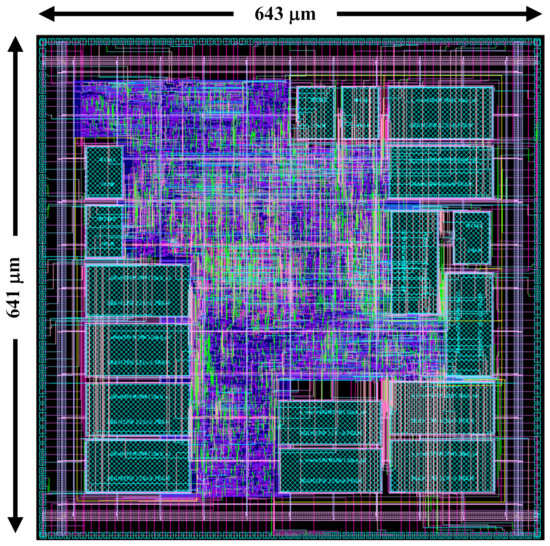
Figure 17.
The ASIC layout of proposed A-PHY RTS architecture.

Table 4.
The summary of ASIC implementation results.
5. Conclusions
In this paper, we proposed an architecture for the retransmission (RTS) layer, proposed an innovative physical layer, and further developed and validated the A-PHY interface, which encompasses the RTS Layer as an emerging vehicular Serializer/Deserializer (SerDes) standard. The proposed RTS hardware architecture integrates the RTS functionality by incorporating a CRC, a message counter (MC), and delay information into the PHY field of the A-Packet. Moreover, the proposed RTS architecture is aligned with the A-PHY interface standard. To validate the proposed A-PHY RTS architecture, an experimental environment utilizing an FPGA board was set up, through which the A-PHY RTS operation was confirmed. Additionally, the designed hardware was implemented as an ASIC. In future work, we plan to verify the MIPI A-PHY standard in a more realistic environment by connecting the source and sink with extremely long cables (up to 15 m) as defined in the A-PHY interface standard.
Author Contributions
Conceptualization, S.-u.S.; methodology, S.-u.S.; software, S.-u.S.; validation, S.-u.S.; formal analysis, S.-u.S.; investigation, S.S. and Y.K.; resources, S.S. and Y.K.; writing—original draft preparation, S.-u.S.; writing—review and editing, Y.K. and J.-K.K.; visualization, Y.K.; supervision, Y.K. and J.-K.K.; project administration, Y.K. and J.-K.K.; funding acquisition, Y.K. and J.-K.K. All authors have read and agreed to the published version of the manuscript.
Funding
This research was supported by the MSIT (Ministry of Science and ICT), Korea, under the ITRC (Information Technology Research Center) support program (IITP-2021-0-02052) supervised by the IITP (Institute for Information & Communications Technology Planning & Evaluation). This work was supported by the National Research Foundation of Korea(NRF) grant funded by the Korea government(MSIT) (No. 2022R1G1A1007415).
Data Availability Statement
No new data were created.
Acknowledgments
The EDA tool was supported by the IC Design Education Center (IDEC), Korea.
Conflicts of Interest
The authors declare no conflict of interest.
Abbreviations
The following abbreviations are used in this manuscript:
| MIPI | Mobile Industry Processor Interface |
| SerDes | Serializer/Deserializer |
| IVN | In-Vehicle Networking |
| RTL | Register Translation Level |
| FPGA | Field-Programmable Gate Array |
| ASIC | Application-Specific Integrated Circuit |
References
- Liu, L.; Lu, S.; Zhong, R.; Wu, B.; Yao, Y.; Zhang, Q.; Shi, W. Computing systems for autonomous driving: State of the art and challenges. IEEE Internet Things J. 2020, 8, 6469–6486. [Google Scholar] [CrossRef]
- Hermann, D.S. Automotive displays-trends, opportunities and challenges. In Proceedings of the 2018 25th International Workshop on Active-Matrix Flatpanel Displays and Devices (AM-FPD), Kyoto, Japan, 3–6 July 2018; pp. 1–6. [Google Scholar]
- Liu, S.; Liu, L.; Tang, J.; Yu, B.; Wang, Y.; Shi, W. Edge computing for autonomous driving: Opportunities and challenges. Proc. IEEE 2019, 107, 1697–1716. [Google Scholar] [CrossRef]
- MIPI Alliance. Meeting the Needs of Next-Generation Displays with a High-Performance MIPI DSI-2 Subsystem Solution. MIPI Devcon 2021, Virtual. Available online: https://www.mipi.org/devcon/2021/agenda/meeting-needs-next-generation-displays-high-performance-mipi-dsi-2-subsystem-solution (accessed on 7 February 2022).
- Zeng, W.; Khalid, M.A.; Chowdhury, S. In-vehicle networks outlook: Achievements and challenges. IEEE Commun. Surv. Tutorials 2016, 18, 1552–1571. [Google Scholar] [CrossRef]
- Den Besten, G.W. 30.1 Single-Pair Automotive PHY Solutions from 10Mb/s to 10Gb/s and Beyond. In Proceedings of the 2019 IEEE International Solid-State Circuits Conference-(ISSCC), San Francisco, CA, USA, 17–21 February 2019; pp. 474–476. [Google Scholar]
- Ahmadi, M.R.; Ying, C. The evolution of automotive interconnect and physical-layer technologies: Ubiquitous pathways enabling intelligent vehicles. IEEE Solid-State Circuits Mag. 2022, 14, 36–43. [Google Scholar] [CrossRef]
- Kraemer, B. Automotive ethernet. IEEE Commun. Mag. 2016, 54, 4. [Google Scholar] [CrossRef]
- Hank, P.; Müller, S.; Vermesan, O.; Van Den Keybus, J. Automotive ethernet: In-vehicle networking and smart mobility. In Proceedings of the 2013 Design, Automation & Test in Europe Conference & Exhibition (DATE), Grenoble, France, 18–22 March 2013; pp. 1735–1739. [Google Scholar]
- Ashjaei, M.; Bello, L.L.; Daneshtalab, M.; Patti, G.; Saponara, S.; Mubeen, S. Time-Sensitive Networking in automotive embedded systems: State of the art and research opportunities. J. Syst. Archit. 2021, 117, 102137. [Google Scholar] [CrossRef]
- IEEE Std 802.3 cb-2018; IEEE Standard for Ethernet—Amendment 1: Physical Layer Specification and Management Parameters for 2.5 Gb/s and 5 Gb/s Operation over Backplane. IEEE: New York, NY, USA, 2019; (Amendment to IEEE Std 802.3-2018)(2019).
- Zinner, H. Automotive Ethernet and SerDes in Competition. ATZelectron. Worldw. 2020, 15, 40–43. [Google Scholar] [CrossRef]
- Varghese, A.A. Automotive In-Vehicle Networks—Ethernet or SERDES? Well....It Is Complicated. Available online: https://www.keysight.com/blogs/inds/2021/01/28/automotive-in-vehicle-networks-ethernet-or-serdes-wellit-is-complicated (accessed on 30 August 2023).
- Browen, C.; Kershner, K. More Cameras, More Connections, More Testing. New Electron. 2022, 55, 14–16. [Google Scholar] [CrossRef]
- Maxim Integrated. Gigabit Multimedia Serial Link (GMSL) SerDes ICs. Available online: https://www.maximintegrated.com/en/products/interface/high-speed-signaling/gmsl.html (accessed on 20 July 2022).
- Texas Instruments. FPD-Link III 4.16-Gbps Serializer with CIS-2 Interface for 2.3MP/60fps Cameras, RADAR, and Other Sensors DS90UB953-Q1 Datasheet; Texas Instruments: Dallas, TX, USA, 2020. [Google Scholar]
- Inova Semiconductors. New Twin Serdes Devices in the Apix3 Family from Inova Semiconductors. Available online: https://inova-semiconductors.de/news-detail/new-twin-serdes-devices-in-the-apix3-family-from-inova-semiconductors.html (accessed on 20 July 2022).
- Brunner, S. Automotive SerDes Alliance (ASA) Completes the First AUTOMOTIVE SerDes Standard with Integrated Security. Available online: https://auto-serdes.org/news/automotive-serdes-alliance-asa-completes-the-first-automotive-serdes-standard-with-integrated-security-325 (accessed on 20 July 2022).
- IEEE Std 2977-2021; IEEE Standard for Adoption of MIPI Alliance Specification for A-PHY Interface (A-PHY) Version 1.0. IEEE: New York, NY, USA, 2021; pp. 1–205. [CrossRef]
- MIPI Alliance. MIPI Alliance Completes Development of A-PHY v1.1, Doubling Maximum Data Rate and Adding New Options to Automotive SerDes Interface. Available online: https://www.mipi.org/mipi-alliance-completes-development-a-phy-v1-1-doubling-data-rate-adding-to-automotive-serdes-interface (accessed on 27 July 2022).
- Saar, H. A Deep Dive into MIPI A-PHY and Its Benefits for Automotive. Available online: https://resources.mipi.org/blog/a-deep-dive-into-mipi-a-phy-and-its-benefits-for-automotive (accessed on 20 July 2022).
- Lida, E. MIPI A-PHY: A Resilient Asymmetric Data Transport for a Vehicle’s Lifespan. Available online: https://www.electronicdesign.com/markets/automotive/article/21168108/mipi-aphy-a-resilient-asymmetric-data-transport-for-a-vehicles-lifespan (accessed on 20 July 2022).
- MIPI Alliance. MIPI Alliance Standard for Camera Serial Interface 2 (CSI-2) Version 1.00; MIPI Alliance: Piscataway, NJ, USA, 2005. [Google Scholar]
- MIPI Alliance. MIPI Alliance Specification for DSI Version 1.1; MIPI Alliance: Piscataway, NJ, USA, 2011. [Google Scholar]
- Widmer, A.X.; Franaszek, P.A. A DC-balanced, partitioned-block, 8B/10B transmission code. IBM J. Res. Dev. 1983, 27, 440–451. [Google Scholar] [CrossRef]
- Kim, Y.w.; Kang, J.K. An 8B/10B encoder with a modified coding table. In Proceedings of the APCCAS 2008-2008 IEEE Asia Pacific Conference on Circuits and Systems, Macao, China, 30 November–3 December 2008; pp. 1522–1525. [Google Scholar]
- Xilinx. High Speed Serial. Available online: https://www.xilinx.com/products/technology/high-speed-serial.html (accessed on 28 July 2022).
- Xilinx. KC705 Evaluation Board for the Kintex-7 FPGA. Available online: https://www.xilinx.com/support/documentation/boards_and_kits/kc705/ug810_KC705_Eval_Bd.pdf (accessed on 22 July 2022).
- Xilinx. Xilinx 7 Series FPGAs GTX/GTH Transceivers User Guide (UG476). Available online: https://www.xilinx.com/support/documentation/user_guides/ug476_7Series_Transceivers.pdf (accessed on 20 December 2021).
- IAM Electronic. FMC Loopback Module. Available online: https://fmchub.github.io/projects/FMC_LOOPBACK/Datasheet/FMC_LOOPBACK_MODULE_datasheet.html (accessed on 20 December 2021).
- Goldman, R.; Bartleson, K.; Wood, T.; Kranen, K.; Melikyan, V.; Babayan, E. 32/28nm educational design kit: Capabilities, deployment and future. In Proceedings of the 2013 IEEE Asia Pacific Conference on Postgraduate Research in Microelectronics and Electronics (PrimeAsia), Visakhapatnam, India, 9–21 December 2013; pp. 284–288. [Google Scholar]
Disclaimer/Publisher’s Note: The statements, opinions and data contained in all publications are solely those of the individual author(s) and contributor(s) and not of MDPI and/or the editor(s). MDPI and/or the editor(s) disclaim responsibility for any injury to people or property resulting from any ideas, methods, instructions or products referred to in the content. |
© 2023 by the authors. Licensee MDPI, Basel, Switzerland. This article is an open access article distributed under the terms and conditions of the Creative Commons Attribution (CC BY) license (https://creativecommons.org/licenses/by/4.0/).